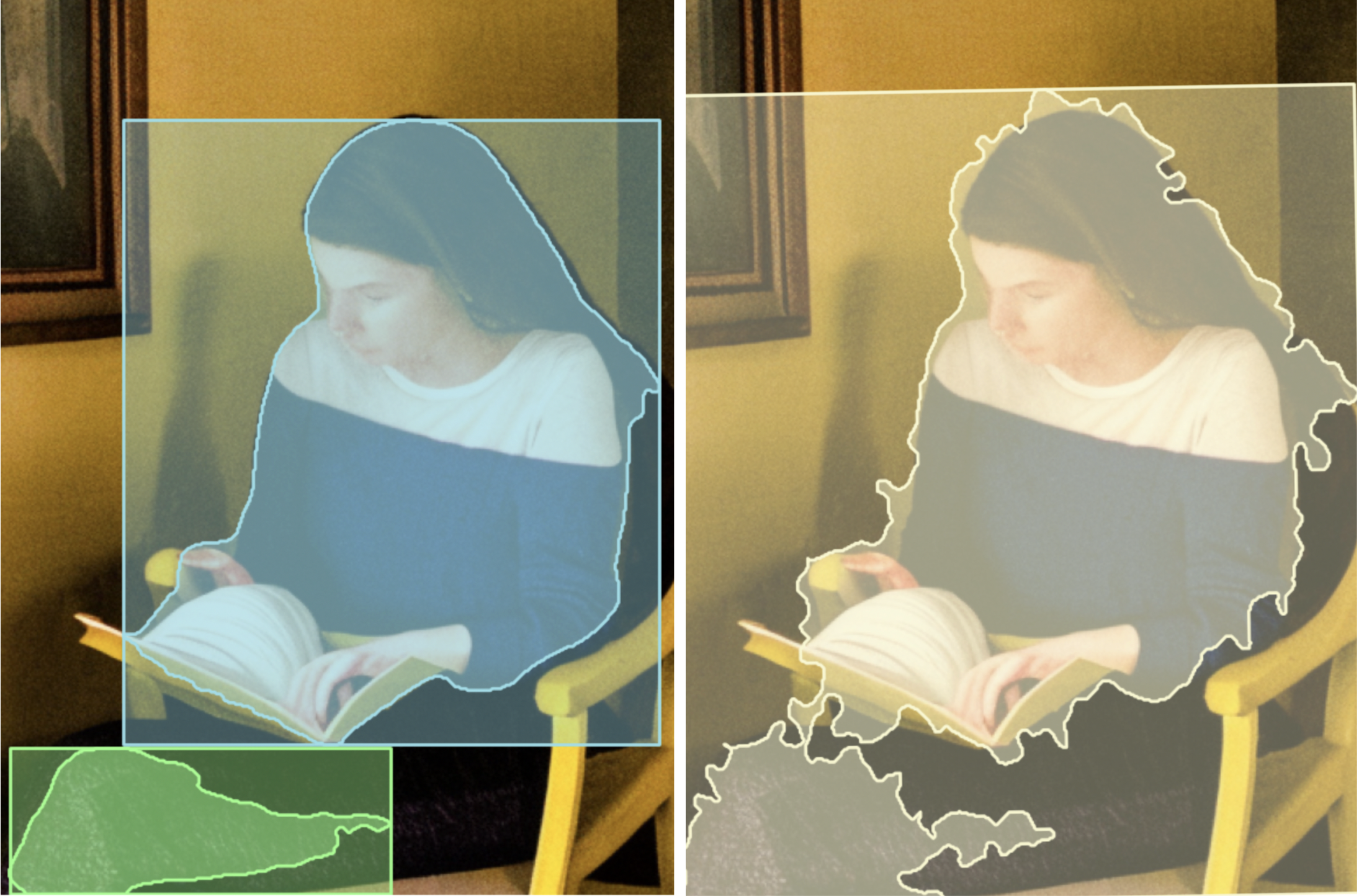DAAM-Image2Image is an extension for Diffusion Attentive Attribution Map which captures image self-attention attention whereas originally DAAM captured only text-image cross-attention. A guided self-attention significantly boost the heatmap qualites. Experiments can be found as updates and notebooks in the Text-Based Object Discovery Repo. Below are some comparisons.
-
The heatmap comparision of DAAM-I2I to Original DAAM on the left. An immediate benefit of
DAAM+DAAM-I2IoverDAAMis segmentation and object detection tasks for the TITAN workflow shown on the right (DAAM-I2Iresults on left andDAAMon the right - detection and segmentation for the objectwoman)

-
In addition to
DAAM's Text-Guided Object Detection,DAAM-I2Ioffers even more capability to glide through the Modelled Vision space for Semantic Image Segmentation (sometimes even better than Segment Anything Model). It is achieved through a graph-inspired pixel attention diffusion (more methods are coming soon). More interesting being the fact that it is completely unsupervised - exploiting zero-shot capability of Diffusion Model. We get segmentation maps for each pixel so only a few are visualized below.
| Semantic Segmentation (Only a Few visualized) | Pixel Attention Diffusion |
|---|---|
 |
 |
 |
 |
 |
 |
 |
|---|
In original DAAM paper, the author proposes diffusion attentive attribution maps (DAAM), a cross attention-based approach for interpreting Stable Diffusion for interpretability of token heatmap over latent images. Here, I use the same approach but extended for latent image self-attention heatmaps.
First, install PyTorch for your platform.
- You may check out the Notebook to get started with the basics.
- If you interested in various merging schemes for generate interesting heatmaps like the one shown above and use them for object detection leveraging TITAN, check out this Colab Tutorial
The following steps are useful for setting up daami2i package in Colab Environment.
!pip install git+https://github.com/RishiDarkDevil/daam-i2i.gitImport and use DAAMI2I as follows:
# Plotting
from matplotlib import pyplot as plt
# Data Handling
import numpy as np
# Image Processing
from PIL import Image
# Image Generation
from diffusers import StableDiffusionPipeline
import daami2i
DEVICE = 'cuda' # device
model = StableDiffusionPipeline.from_pretrained('stabilityai/stable-diffusion-2-base')
model = model.to(DEVICE) # Set it to something else if needed, make sure DAAM supports that
prompt = 'Dinner table with chairs and flower pot'
# Image generation
with daami2i.trace(model) as trc:
output_image = model(prompt).images
global_heat_map = trc.compute_global_heat_map()
display(output_image[0]) # Output imageThere types of heatmaps available are:
-
Pixel-based: The pixels are numbered in row-major order i.e.
- 0 1 .. 63
4032 4033 .. 4095
Only latent image height and width is valid (i.e. 64 x 64 for Stable Diffusion v2 base) so the pixels that can be mentioned is a list (i.e. from 0 ... 4095 for SDV2).
# Example # Compute heatmap for latent pixel lists row-major. It will return the heatmap for pixels [0,1,..,1023] pixel_heatmap = global_heat_map.compute_pixel_heat_map(list(range(1024))).expand_as(output_image[0]).numpy() # Casting heatmap from 0-1 floating range to 0-255 unsigned 8 bit integer heatmap = np.array(pixel_heatmap * 255, dtype = np.uint8) plt.imshow(heatmap)
- 0 1 .. 63
-
BBox-based: The bounding box's upper left and bottom right corner needs to be specified. Again latent height and width are valid ranges (i.e. for SDV2 the top-left corner of the bbox cannot be more lefter or higher than 0,0 and the bottom-right corner of the bbox cannot be more righter or downer than 63,63).
# Example # Compute heatmap for latent bbox pixels with corners specified pixel_heatmap = global_heat_map.compute_bbox_heat_map(0,10,25,64).expand_as(output_image[0]).numpy() # Casting heatmap from 0-1 floating range to 0-255 unsigned 8 bit integer heatmap = np.array(pixel_heatmap * 255, dtype = np.uint8) plt.imshow(heatmap)
-
Contour-based:. The image height and width can be different from the latent height and width. Enter contour and attention map will be generated for that contour containing pixels i.e. if you have a contour for the generated image (say 512 x 512) then the contour lines will be on this bigger image and not on the latent image. While calling make sure to pass the image size as shown below.
# Example # Compute heatmap for inner pixels for contour boundary specified pixel_heatmap = global_heat_map.compute_contour_heat_map([[0,300], [256, 100], [512, 300], [512, 400], [0, 400], [0, 300]], 512, 512).expand_as(output_image[0]).numpy() # Casting heatmap from 0-1 floating range to 0-255 unsigned 8 bit integer heatmap = np.array(pixel_heatmap * 255, dtype = np.uint8) plt.imshow(heatmap)
-
Multi-Contour based: To handle merging pixel heatmaps for multiple contours. It is an extension for the
compute_contour_heat_mapwhich can handle only single contour. Function:compute_segmentation_heat_map -
Guided Heatmap-based: It merges all the pixel heatmaps based on some weighing scheme provided by another heatmap called the
guide_heatmap. Theguide_heatmapshould be of the dimension of the latent image. Function:compute_guided_heat_map -
Pixel-Diffused Heatmap-based: It starts with the Pixel Heatmap of a given pixel and then iteratively reweighs all the other pixels based on this heatmap for given number of iteration. It enhances the parts which a pixel focuses the most. Currently it only has
thresholdingmethod to remove the noisy or unwanted (low-scored pixel heatmaps which if not removed will amplify giving worse diffused heatmap). Function:compute_pixel_diffused_heatmap. -
Diffused Heatmap-based: Parameters include
method,n_iterandthresh. The diffused heatmap for all the pixels are calculated at once (faster thancompute_pixel_diffsed_heatmap). Function:compute_diffused_heatmap
track_allargument added totracefunction, which not only tracks the attention heatmap for the attention layers of the size of the latent image but also throughout the UNet. This makes it possible to visualize the attention of each pixel at a better semantic level.
DAAM-I2I: Add Link to this project as citation in your work.